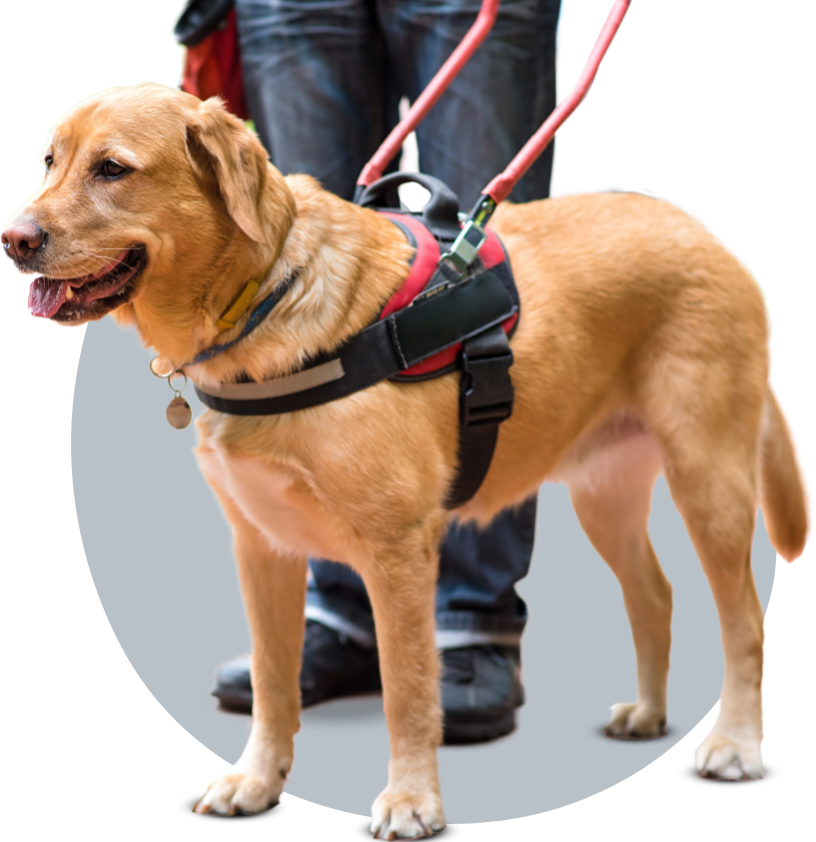Feeding Your Service Dog Less May Lead to a Longer Life

Most people love their pets, but for the disabled, a service dog isn’t just a beloved friend. They are an essential part of their lives, and vital to their independence. Service dogs are employed around the world to help guide the blind, alert deaf to important sounds such as doorbells or phones, and to alert to a wide range of medical conditions.
It can cost between $20,000-$60,000 to properly train a service dog and replacing them when they become too old to work or pass away is both heart wrenching and difficult. Both the handler and the dog must learn to work with a new person, and there’s no guarantee that the match will work.
Between the expense and the level of effort it takes to transfer to a new service dog, it makes sense to keep a beloved friend in service for as long as possible. The good news is, keeping your dog in good weight can not only extend his life, but make those years higher quality as well.
Weight gain is a growing problem for dogs
In the United States alone, 54% of dogs are overweight or obese. A 2014 study conducted by Banfield pet hospitals found that overweight dogs live shorter lives than those who are a healthy weight. The difference in lifespan came to about 2 ? years.
Overweight dogs are also prone to a number of chronic diseases such as diabetes, arthritis, and even ACL tears. These problems may shorten your pets lifespan, but critically for service dogs, could bring an end to their career.
If they ever have to undergo surgery, they are also more at risk because overweight dogs have to work harder to breathe and may take longer to wake up after anesthesia.
Feeding less is the best choice
Weight loss happens when a dog takes in fewer calories than it burns. While you can increase exercise in the hopes of helping your pet burn calories, the reality is your service dog probably already gets plenty of exercise every day as he performs the tasks required of him.
The saying goes, “You can’t outrun a bad diet,” and is meant as advice for runners who hope to lose weight through adopting running as an exercise routine. The same is true for dogs. Although exercise can help burn more calories, your service dog’s diet is where we truly need to look in order to help him lose weight. There are several methods you can use to help him lose weight, including:
Stop free feeding

Some people choose to keep unlimited amounts of food available for their dog. The theory being that a full dog won’t beg, and that they won’t overeat if they know there is always more food available. Dogs are opportunistic feeders however, and tend to eat more than they should, especially if it is readily available to snack on at a moment’s notice.
Instead, carefully read the instructions on your dog’s food, and follow the guidelines. These guidelines are different from brand to brand, and even between lines of the same brand.
Follow package instructions carefully
Different brands of dog food have different calorie amounts. A cup of food for one brand could have a vastly different calorie count than a cup from a different brand, even though it is the same volume. Read the package carefully, and double check that you are following instructions properly. Some people read the daily intake suggestion and think 1 cup per meal for example, and it is actually 1 cup per day.
If you want to feed multiple meals per day, split the daily value total into portions, rather than accidentally doubling or tripling the amount of dog food your pet receives with multiple meals of his daily value.
Get a body scale done on your dog
Most vets are happy to perform a body scale assessment on your dog, so that you know how far you need to go. They will give you a number between 1-5, with 1 being completely emaciated and 5 being morbidly obese. A body scale can let you know your dog’s condition and help guide you towards a healthy weight.
Include treats in overall feed amount
Many people forget that the treats and chews they offer their pet throughout the day also have calories. When feeding your service dogs his main meal, it’s important to subtract the amount of treats you have given from the total amount of kibble for the day.
Treats can add up to a surprising number of calories if you give them frequently, so if you love giving your service dog a few extras when it is off duty, this may be the culprit to his expanding waistline.
Feed less
If you have been carefully measuring your dog’s food, either by weighing it or by following the package instructions and your dog has not lost weight, it’s time to cut the amount of dog food. The measurements on the back of your dog food are simply guidelines, and they don’t always accurately reflect your dog’s needs.
Age, level of activity, and chronic diseases such as thyroid problems can slow down your dogs metabolism and make him need less than the recommended amount. If you see no change in his weight after reducing his food, it’s time to cut how much is getting in his bowl.
How much to cut your dog’s food

If you always measure your dog’s food and follow the guidelines on the back of the bag, you may be wondering where to go from there. Your dog food may suggest different measurements depending on energy requirements, but a good rule of thumb is to reduce the food you are giving your dog by 5% and then wait a few weeks to see how effective that is.
The delay between food reductions gives your service dog a chance to get used to the smaller amount of food, as well as time to lose weight. If he hasn’t lost enough weight after a few weeks, you can reduce the amount again. If you find yourself feeding less than 75% of the daily recommended amount, it may be time to switch to a lower calorie food instead.
Feeding your dog the correct amount of dog food can be tricky. The weight ranges on dog food labels can be huge and make it hard for you to guess what the appropriate amount is. Many labels also fail to meet standard calculations.
Your service dog will probably need to be on a diet for somewhere between 6-8 months in order to achieve a healthy body weight. Even just five pounds could take over a month as your dog gradually loses the weight.
Even if your dog has a lot of weight to lose, it’s important not to rush your dog’s weight loss. Rapid weight loss can have problems of its own, such as nutritional deficiencies, or even behavior problems such as digging through your trash.
It’s healthiest for your pet to lose the weight gradually, so that he has time to adjust to the reduced amount of food before making more adjustments. Your vet can be a very helpful guide here, letting you know if weight loss is too much or not enough.
Even if the weight loss is gradual, you will notice a difference in how your service dog is working as the weight comes off and he enjoys more energy and better health. Weight loss is a long term project, and is the same for people as it is for dogs. The best chance for your pet to not only lose the weight but also keep it off is a slow approach.
Why less food is so important
Most service dogs are larger dogs, such as labs and shepherds. On a medium to large sized dogs, a few extra pounds aren’t as noticeable compared to a couple of extra pounds on a tiny yorkie. Yet even just a few extra pounds on your service dog can not only decrease his lifespan, but also his quality of life. According to VCA dog hospitals, just 5 pounds of extra weight can be enough to put your dog at risk for chronic health conditions. The smaller your dog is, the more those extra pounds can stress the body.
Your service dog is a partner that gives you independence. Making sure he is healthy enough to continue to help you for as long as possible is a sensible step and is as easy as pouring a few less kibble into his bowl. He might not love a diet, but he will love the good health he can enjoy well into his twilight years as your partner in life.














































































